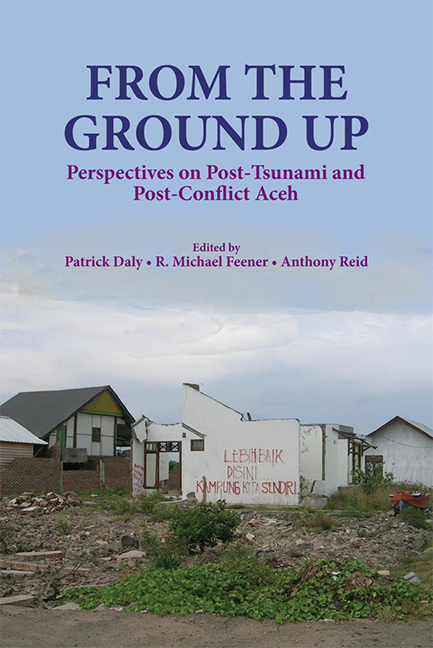Book contents
- Frontmatter
- Contents
- Preface
- List of Figures and Tables
- The Contributors
- Glossary and Abbreviations
- Introduction: Unpacking the Challenges of Post-2004 Aceh
- 1 The Sunda Megathrust: Past, Present and Future
- Part I Reconstruction Efforts
- 2 Disaster Recovery: An International Humanitarian Challenge?
- 3 Linking Relief, Rehabilitation and Development (LRRD) to Social Protection: Lessons from the Early Tsunami Response in Aceh
- 4 Cultural Heritage and Community Recovery in Post-Tsunami Aceh
- 5 Managing Post-Disaster Reconstruction Finance: International Experience in Public Finance Management
- 6 Between Custom and Law: Protecting the Property Rights of Women after the Tsunami in Aceh
- 7 Factors Determining the Movements of Internally Displaced Persons (IDPs) in Aceh
- 8 Aceh's Forests as an Asset for Reconstruction?
- Part II Conflict Resolution
- Index
4 - Cultural Heritage and Community Recovery in Post-Tsunami Aceh
from Part I - Reconstruction Efforts
Published online by Cambridge University Press: 21 October 2015
- Frontmatter
- Contents
- Preface
- List of Figures and Tables
- The Contributors
- Glossary and Abbreviations
- Introduction: Unpacking the Challenges of Post-2004 Aceh
- 1 The Sunda Megathrust: Past, Present and Future
- Part I Reconstruction Efforts
- 2 Disaster Recovery: An International Humanitarian Challenge?
- 3 Linking Relief, Rehabilitation and Development (LRRD) to Social Protection: Lessons from the Early Tsunami Response in Aceh
- 4 Cultural Heritage and Community Recovery in Post-Tsunami Aceh
- 5 Managing Post-Disaster Reconstruction Finance: International Experience in Public Finance Management
- 6 Between Custom and Law: Protecting the Property Rights of Women after the Tsunami in Aceh
- 7 Factors Determining the Movements of Internally Displaced Persons (IDPs) in Aceh
- 8 Aceh's Forests as an Asset for Reconstruction?
- Part II Conflict Resolution
- Index
Summary
Our experiences in Aceh lead us to believe that a surprising amount of the reconstruction and development agenda has failed to address the cultural and historical dimensions of social recovery. In spite of all the meetings, coordinating sessions and public statements about interagency cooperation, it is impossible to find a commonly-accepted definition of what ‘recovery’ entails or should look like. It is difficult to imagine such resources could be allocated and spent without a clearly-defined end-game, but unfortunately this is an endemic problem in many post-disaster situations (Bennett et al. 2006; Telford and Cosgrave 2006). The evidence from Aceh suggests that this is specially a concern when there are large numbers of external organizations involved in aid and reconstruction processes.
Naomi Klein's influential book The Shock Doctrine draws attention to the cynical and opportunistic behaviour often accompanying post-conflict and post-disaster reconstruction processes. She builds a powerful argument that government and corporate interests exploit the aftermath of large-scale social trauma for political and/or economic gain, and in some cases initiate or encourage trauma (Klein 2007). While there are certainly cases where relief and development aid is manipulated to achieve political, economic or social goals, we want to argue in this chapter that practices which target social transformation that fall outside pre-existing social and cultural contexts can impede the recovery of traumatized communities, even when it is brought about through the interventions of well-meaning individuals and organizations. Our research focuses upon cultural and social mechanisms for community recovery, and how these are related with the material world. We argue that there are aspects of post-disaster recovery that are contingent upon reconnecting with familiar cultural and social practices, which in turn are intimately connected with the built environment. Aid and reconstruction efforts that further remove people from familiar physical and social contexts run the risk of pulling them away from the basic community infrastructure that is necessary for recovery.
- Type
- Chapter
- Information
- From the Ground UpPerspectives on Post-Tsunami and Post-Conflict Aceh, pp. 57 - 78Publisher: ISEAS–Yusof Ishak InstitutePrint publication year: 2012

